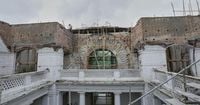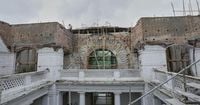Five months after a devastating 7.7-magnitude earthquake struck Myanmar, the country remains caught in a relentless struggle to rebuild while its civil war rages on. On March 28, 2025, the earthquake centered in Myanmar’s Mandalay region toppled buildings, shattered infrastructure, and claimed more than 3,800 lives, according to figures reported by the Associated Press. The disaster unfolded against the backdrop of a nation already divided by violence, where armed militias and pro-democracy forces continue to challenge the military-led government that seized power in 2021.
For Thae Mama Swe, a 47-year-old seamstress, the aftermath is painfully personal. Each day, she stands atop the rubble of a collapsed 10-story condo and office building in Mandalay, watching as excavators claw through debris in search of victims. Her son remains missing, one of nearly 200 bodies recovered from the site so far—including seven found in the week before September 4, 2025. Through tears and monsoon rain, she told the Associated Press, “If it were possible, I would exchange my life for his.”
The earthquake’s devastation is visible everywhere: roads buckled, temples crumbled, and hospitals reduced to twisted metal and concrete. Along the main highway from Yangon to Mandalay, toppled Buddhist pagodas and fractured pavement serve as grim reminders. Official statistics confirm that in the Mandalay region alone, nearly 29,000 homes, 5,000 pagodas, and 43 bridges were either completely or partially destroyed.
Yet, as Myanmar attempts to rebuild, violence is never far away. Although all sides declared a ceasefire immediately after the earthquake, fighting never truly stopped. The United Nations’ appointed human rights expert for Myanmar, Tom Andrews, told AP that military airstrikes and artillery attacks have continued—including on civilian targets and in earthquake-affected areas. These attacks have slowed or halted the delivery of humanitarian aid to many regions. “The junta has to stop killing people, it’s as simple as that,” Andrews said. “And they need to stop obstructing aid.”
Even before the earthquake, the United Nations estimated that over 3.5 million people had been displaced by fighting, and about 20 million were in need of assistance by September 2025. The situation has only worsened since, as the military continues to restrict aid to areas outside its control, according to the UN Office of the High Commissioner for Human Rights.
The military, known as the Tatmadaw, denies blocking aid or targeting civilians. Zaw Tun Oo, head of the protocol department at Myanmar’s Foreign Ministry, told the Associated Press, “We are only doing it in self-defense when the enemy comes and attacks us.” The ministry’s own building was among those badly damaged by the quake. Several aid organizations, dependent on the regime’s permission to operate, declined to comment on the situation.
Logistical challenges compound the crisis. The destruction of roads, bridges, hospitals, and schools has made it even harder to deliver critical supplies and shelter to the worst-hit areas. Military engineers have erected temporary bridges to replace those destroyed, and repairs are underway on others that remain standing. Meanwhile, pro-democracy forces have continued to attack along major roads, heightening the dangers for aid convoys and reconstruction teams.
Myanmar’s economic woes have only deepened. Although the country maintains some trade with China, Russia, and other nations, Western sanctions have further strained an already struggling economy. Shortages of supplies and equipment are common. The situation has been exacerbated by recent cuts to foreign aid from the U.S. government, which have left both UN organizations and other groups operating inside Myanmar scrambling to meet humanitarian needs. “The lack of American logistical help has been especially acute, including the transport of aid and heavy equipment to remote areas,” Andrews noted. In the past, such assistance was routine.
Despite these obstacles, reconstruction efforts press on. In Naypyitaw, the capital, up to 500 workers are laboring day and night to repair the five most important buildings in the parliament complex, aiming to have them ready for elections scheduled at the end of December. Scaffolding fills entire chambers as crews shore up foundations and repair collapsed ceilings and walls. Officials view the restoration as symbolically crucial, hoping the main parliament buildings will be ready for new lawmakers to gather for their first session.
However, critics argue that the upcoming elections are merely a sham intended to legitimize the military’s grip on power. The National League for Democracy (NLD), led by Aung San Suu Kyi, was dissolved after the military coup prevented it from starting its second term following a landslide victory in 2020. Opposition organizations—including armed resistance groups—have pledged to try to derail the elections, arguing that they cannot be considered fair or representative. The National Unity Government, formed by elected lawmakers barred from taking their seats, did not respond to AP’s request for comment.
Elsewhere in Naypyitaw, teams of about 40 workers, primarily women, toil to repair roads at a dozen different sites. Much of the work is done by hand: laborers carry baskets of large stones on their heads and shoulders to form the foundation, followed by gravel and finally asphalt. The process is slow and grueling, but officials say Myanmar needs help from countries experienced in constructing earthquake-resistant buildings. Aye Min Thu, chief of the Mandalay division of Myanmar’s disaster management agency, expressed hope: with international assistance, Myanmar could “build a resilient society” so that “future generations will not be easily destroyed.”
At the site of one of the capital’s largest hospitals, only rusted rebar, plastic pipes, and concrete remain, sorted into piles for removal. Hospital beds and furniture are stored under a shelter for possible reuse, but Thin Thin Swe, the engineer overseeing the project, said it’s unclear whether Ottara Thiri Hospital will be rebuilt. She lost two friends—the hospital’s accountant and pharmacist—when the main lobby collapsed. “I still pray for them every day,” she said.
Recovery work has taken a toll on first responders as well. Mandalay’s fire chief, Kyaw Ko Ko, shared the emotional burden his teams face, especially when they recover the bodies of children. “They could easily be my own relatives or family members,” he said.
For families like Thae Mama Swe’s, the wait continues. She spoke of the guilt she feels over her son’s death, since he was only in the building because she encouraged him to return to Mandalay. Her greatest hope is to recover his body, an essential part of Buddhist religious rites. “I will never give up hope for that,” she said. “Then his soul will be free, and I can live peacefully.”
As Myanmar’s people struggle to rebuild amid the ruins of disaster and the ongoing strife of civil war, their resilience is tested daily. The road ahead remains uncertain, but for many, hope endures against all odds.



